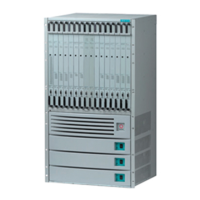Beta Draft Confidential
21-81/19/05 ATM Services Configuration Guide for CBX 3500, CBX 500, GX 550, and B-STDX 9000
Configuring PNNI Routing
PNNI Routing Protocol Overview
PNNI Routing Protocol Overview
The PNNI routing protocol provides for dynamic routing configuration and a highly
scalable routing scheme. In an ATM network, nodes (switches) that support PNNI
routing are organized into peer groups. Each peer group is identified by a peer group
identifier. All nodes within the same peer group have identical peer group identifiers.
A peer group identifier consists of two parameters:
1st byte — peer group level (0 – 104)
Bytes 2-14 — peer group identifier
Each switch within a peer group is identified by a PNNI node identifier. The switch
derives the node identifier by concatenating its peer group level, the hexadecimal
value 0xA0, and its 20-octet private ATM address. (If the ATM address is not
configured, its value defaults to the concatenation of the peer group identifier and the
Media Access Control [MAC] address of the switch.) For more information about
these PNNI node parameters, see “Configuring PNNI Node Parameters” on
page 21-43.
Hierarchical Organization
Peer groups can be organized hierarchically. To accomplish a hierarchical
organization of peer groups, each peer group is represented to the next level of
hierarchy by an abstract entity called a logical group node (LGN). A node in the child
peer group, called the peer group leader (PGL), performs the logical group node
functions. Members of the peer group communicate to elect the PGL based on
leadership priority. If a node is configured with a higher leadership priority value than
zero (0), it is eligible to become the PGL of a peer group. The member that has the
highest leadership priority is chosen to be the PGL. The PGL summarizes information
and supplies that information to the LGN in the next level.
Note – To ensure redundancy if a PGL is disabled, Lucent recommends that you
configure at least two PGL-capable switches for each lower-level peer group in the
hierarchy.
Configuring a PGL is not necessary, nor is it recommended, at the highest peer group
level in the hierarchy.
For more information about configuring PGL leadership priority, see Table 21-4 on
page 21-44.

